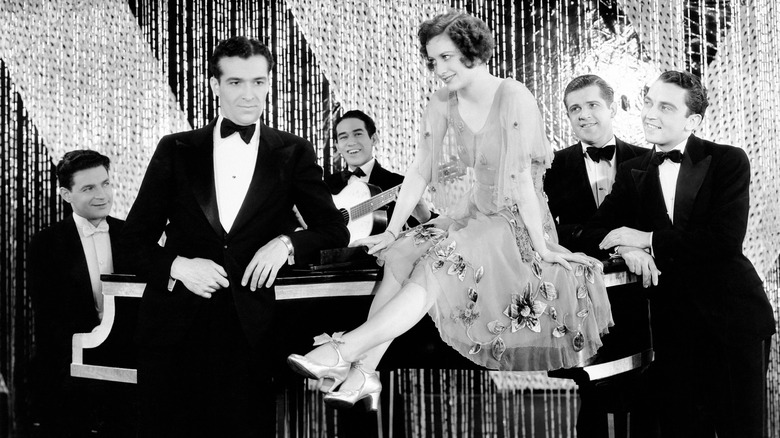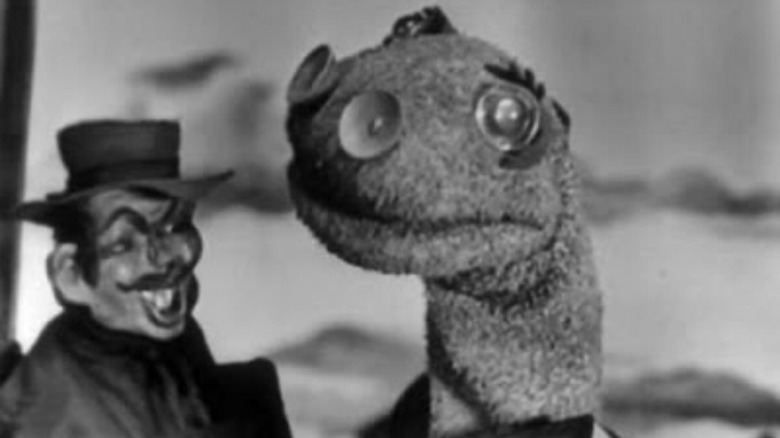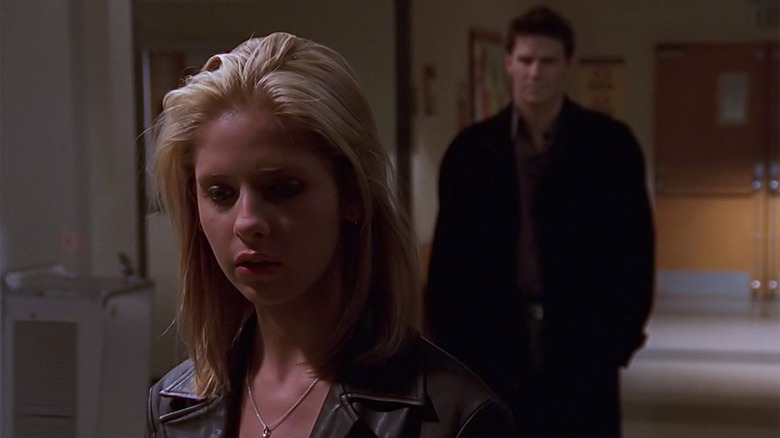Paramount Tried To Combine Movie Theaters With TV - And It Failed Spectacularly
At the Academy Awards in 1929, Charles Reisner's "The Hollywood Revue of 1929" was nominated for Best Picture. "Revue" is a relative obscurity to modern audiences — even less well-known than that year's Best Picture winner "The Broadway Melody" — and it may even baffle certain viewers. True to its title, "The Hollywood Revue" is a collection of musical numbers, comedic sketches, and dramatic scenes, all played out "live" on a theater stage. A curtain closes and opens in between each number, and two emcees — Jack Benny and Conrad Nagel — introduce each vignette.
Such filmed stage performances may look a little odd to the modern eye, but they were common throughout the '20s and '30s. Few audiences (outside of New York, anyway) had access to high-end live theater, and Hollywood was happy to step in to provide. Studios would distribute such revues as, essentially, a Broadway substitute, allowing distant viewers to experience the theater events they read about in the papers.
Filmed revues, however, fell out of favor in the 1940s, mostly because cinema was becoming a more codified medium. It also didn't help that television could outstrip filmed revues by providing audiences with live broadcasts of theater shows or, even more novel, sporting events. Only concert films survived in movie theaters, and it's a trend that persists to this day (one of the biggest films of 2023 was Taylor Swift's "The Eras Tour").
Bernard F. Dick's 2021 book "Engulfed: The Death of Paramount Pictures and the Birth of Corporate Hollywood," fills in that obscure interstitial chapter of Hollywood history, when the blending of theater and cinema gave way to the separation of cinema and television. It also recalls a misguided attempt by Paramount to, sometime in the late '40s, shunt TV signals into theaters.
It wasn't well-received.
TV in the movies
Paramount, of course, wasn't afraid of the introduction of television and was eager to embrace the new medium. Indeed, Paramount has overseen TV for 80 years, backing some of your favorite shows. So eager were they, that a Paramount electrical engineer named Paul Raibourn felt that combining TV and movies was going to be the next technological wave. TV, as Marshall McLuhan would note, is a medium best suited for live events and immediate consumption. TV took off because it offered the kinds of live musical programming and live sporting events that cinemas couldn't deliver with equal immediacy.
Raibourn, meanwhile, invented a way to broadcast live TV signals into theaters and project them on theater screens ... long before the days of Fathom Events or miniature digital projectors. Raibourn was so keen on this idea, and so eager to sell it, that he was promoted to the then-new position of Paramount Television Productions. This embracing of TV eventually proved to be a wise move, as movie theaters would take a huge financial hit in the early 1950s thanks to the proliferation of televisions. A lot of studios competed with TV by offering new, premiere theatrical-only experiences. Enhanced sound came into vogue, while 2.39:1 Cinemascope aspect ratios burst onto the scene in 1953 with the release of "The Robe." Other filmmakers experimented with 3-D.
Recall that many of the movie theaters at the time (back when Paramount owned a great number of them) also served as live performance venues. One night, one could see Frank Sinatra live, and the next night, one could watch a movie. Paramount felt that they could broadcast live events instead of hosting live performances.
Welcome to the UPN
Paramount learned the hard way that audiences would rather watch the broadcast events at home — the music-forward "Ed Sullivan Show" debuted in 1948 — and the movies in theaters. There was no future for "TV at the movies."
Who knows how the technology would have worked, as the technology to project a TV signal on a big screen hadn't yet been pioneered. It was an ambitious idea well ahead of its time. Even in 2024, the idea of watching a major televised event in a theater is seen as somewhat gauche, reserved only for niche audiences and nerd gatherings.
Paramount continued to pursue TV, but they weren't able to create a network to compete with the rise of CBS and NBC. The next major contender in the TV wars wasn't Paramount's, but ABC. By 1951, ABC had become so large as to purchase Paramount's theater chain (which they were forced to do by Supreme Court decree). By 1959, the last remnants of Paramount's TV department were purchased by a company called Metromedia. Any dreams of a Paramount TV network were dead. Eventually, even Metromedia would be bought out by Rupert Murdoch, erasing Paramount's TV dreams from history.
Of course, the dream never died entirely, and in 1995, Paramount launched the UPN, a new network for a hip, '90s audience. Apart from a few scant hits — "Buffy the Vampire Slayer," "Star Trek: Voyager" — the UPN never took off either, though. After 11 years of stalled attempts at premiering hip new programming, the UPN merged with The WB to become The CW. Over the decade, the venture would lose a billion dollars.
Now in 2024, Paramount is at the risk of being purchased by other companies.


